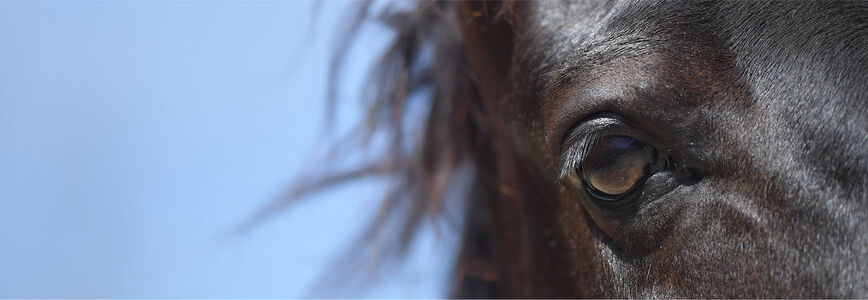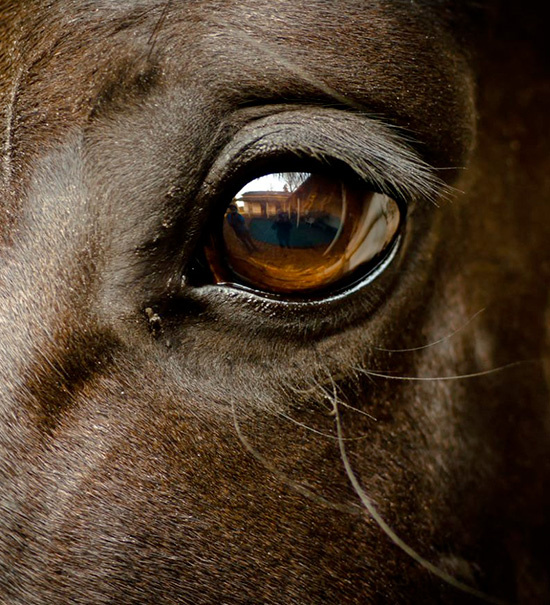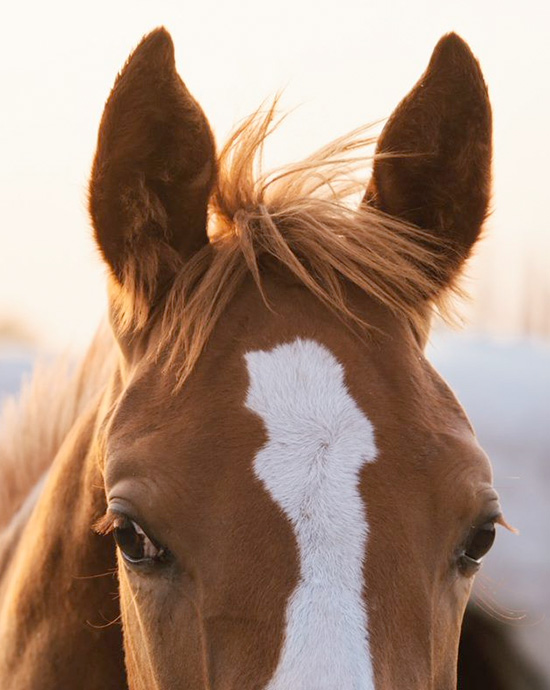
The eyes of horses: they are the mirror of the soul of these beautiful animals. Learn more here.

The horse's eye in detail.
A horse's beautiful big eyes say a lot about its state of mind and health. An animal with shiny and lively eyes is doing well. However, if the eyes are dull and look inward, the horse probably has a physical or mental problem and is not feeling well. In fear and panic, horses tear their eyes wide open, causing parts of the white sclera around the iris to flash. This sign should be taken seriously, because a panicked horse can be dangerous. The wrinkles around the eyes can also speak volumes: for example, a steep wrinkle as a supposed "eyebrow" can express pain or show worry. Food envy, for example, can also be read from the angle of the wrinkles. It is important to understand how horses perceive the world, how and why they react in certain ways to shadows and changes in light. When you, as a horse lover, venture out on a ride with the beautiful four-legged friends, it often helps to understand how everything actually looks from the horse's point of view.

In terms of distance, colour, visual field and imagery, the structure of horse eyes is very different from that of humans.
Horses, unlike some other mammals, can certainly perceive colours. Unlike humans, however, they can only see two of the three discernible wavelengths in the light spectrum. For example, if you give your pet a bright red apple or an orange carrot, it will see them as brownish or greenish. Horses, on the other hand, can easily distinguish between blue and green - just like colour-blind people.
Because their eyes are located on the side of their heads, horses have 360-degree vision and can see far away. As they are prey animals, this has a particularly positive effect in dangerous situations. For example, when someone approaches from behind at a short distance. This is why it is very important - for example when working with warm-blooded horses - to first talk to them well before moving behind them. Because the retina in horses is very large, you have good peripheral vision. Just a slightly subtle turn of the head allows them to focus on an object.
Horses can gallop easily even in the dark without tripping over bumpy railings. Their good night vision comes from the fact that they have more structures in their eyeballs that absorb light. It is often the case that the horse's eye looks almost ghostly white in a picture. This is caused by the tapetum lucidum, a membrane in the back of the eye that reflects light and at the same time promotes night vision.
Anyone who has ever walked into a barn at night and suddenly turned on a light knows that horses then continue to blink for a very long time. The adaptation to strongly changing light conditions takes a little longer than in humans. This can also explain, for example, why some horses hesitate for a long time to get into dark trailers. Their gentle horse eyes have to get used to the change from bright sunlight to darkness. The sudden changes in light conditions simply give the eyes less time to adjust.
Horses usually have brown or blue eyes. However, brown eyes are far more common. Horse breeds with a high proportion of blue eyes include Pintos, Appaloosas and Paint Horses. Extremely rarely - often merely as a lighter shade of brown eyes - light green, grey, yellow or even violet eyes also occur. As far as most piebalds or horses with large markings are concerned: In some quadrupeds the iris is partly genetically shimmering white, so that one can always see a light rim.
The protective layer in the corner of the eye, called the nictitating membrane, helps to prevent irritation from dust and objects such as grass seeds and stalks. The nictitating membrane also takes over a large part of the mucus production and is important for the tear production of the eye.